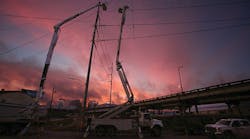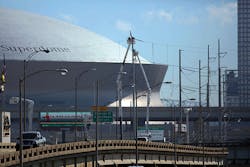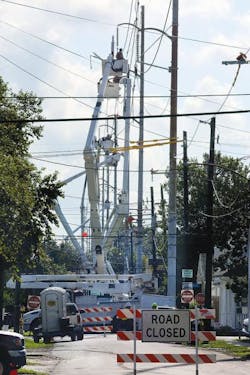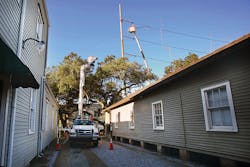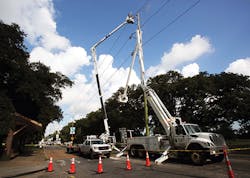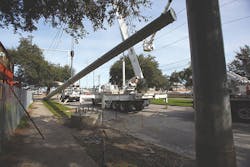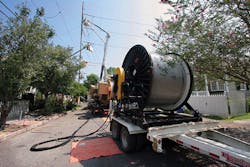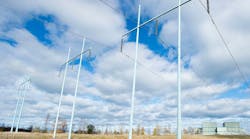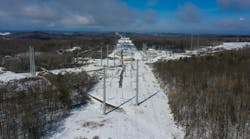New Orleans, Louisiana, U.S., is a city known for its food, history and culture. The streets of New Orleans are home to Mardi Gras parades, streetcar tracks, seafood restaurants and shotgun houses. Lining some of these streets is Entergy New Orleans’ transmission infrastructure. The steel poles and wires have existed in place for decades and faded into the background of the busy urban environment. This is the way most transmission infrastructure exists in a busy city — until the poles need to be repaired or upgraded. It is then these 100-ft (30.5-m) poles and miles of wires become apparent and enter the forefront of everyone’s mind.
In 2014, Entergy decided to decommission its Michoud power station in New Orleans. The 875-MW generating station had been providing peak power throughout the city of New Orleans for more than half a century. In order to retire the generation station, Entergy needed to bring power into the city from other locations. A US$30 million project to upgrade two transmission lines fed from Entergy’s Ninemile generating plant was initiated.
The extensive project would upgrade 12 miles (19.3 km) of 230-kV transmission lines, enabling full delivery of lower-cost power from Entergy’s efficient Ninemile power plant. The 230-kV Ninemile-Derbigny and Ninemile-Napoleon transmission lines to be upgraded were built in the 1960s. The lines exit the Ninemile generating plant, cross over the Mississippi River and traverse through the congested city streets of New Orleans.
Line Details
The Ninemile-Napoleon transmission line follows the Mississippi River levee, turns onto Magazine Street and then heads to the Napoleon substation. The Ninemile-Derbigny transmission line is also routed through highly populated areas and heads through the center of the city toward the Derbigny substation near the Mercedes-Benz Superdome. Magazine Street is known for its many shops, galleries, restaurants, large oak trees, and the entrance to the Audubon Zoo and park. The Ninemile-Derbigny transmission line passes through a private university and crosses over Interstate 10 several times.
The lines have an average ruling span of 300 ft (91 m) and were built on steel monopoles with distribution underbuild. The lines originally had a capacity of 1607 A and contained three phases of 1780 aluminum conductor steel-reinforced (ACSR) Chukar conductor. To provide the city with enough power, both transmission lines needed a current capacity of at least 2100 A.
Design with Diver Conductor
The magnitude of the effort was daunting, as the upgrade would be a significant construction effort. The Entergy project team was tasked with finding solutions to reduce impact to city businesses and communities. An aggressive timeline and a city fatigued with numerous hurricane-related infrastructure projects only raised the stakes.
To tackle the challenge, the engineering team evaluated multiple high-ampacity, low-sag conductors. The 3M 1272 aluminum conductor composite-reinforced (ACCR) Diver conductor was lighter and sagged less than existing ACSR conductors while providing 2179 A at its maximum operating temperature of 392°F (200°C). Most importantly, the Diver conductor enabled existing poles to be reused. Avoiding the installation of new, massive foundations and poles would reduce disruption to the city and keep the project budget in check.
A light detection and ranging (LiDAR) survey was performed for the line corridor. PLS-CADD was used to design the line. The transmission lines were modeled with the 3M 1272 ACCR Diver conductor and used to analyze the poles and insulators. Conductor clearances were checked to verify existing clearances remained over streets, highways and distribution infrastructure.
Construction and Communication
Designing the line was the easy part. Next, Entergy employees had to plan the construction. Challenges were apparent from the start. Existing davit arms and insulators had to be replaced on more than 200 poles. This meant bucket trucks and cranes would have to be paraded down the narrow city streets each morning and evening. Construction equipment and materials would cause lane closures on busy streets during most of the day. Many of the poles had limited access and were located in the front yards and parking lots of customers. Entergy employees focused on strategies and technologies that involved as little disruption to customers as possible. Keeping the public safe and informed was a primary goal.
In the 12 miles (19.3 km) of reconductor, Entergy coordinated with the city of New Orleans, Orleans Levee Board, Louisiana Department of Transportation, U.S. Army Corps of Engineers (USACE), other organizations as well as the general public and area businesses. Close partnerships with city officials, businesses, residents and others informed the utility’s planning and execution. A broad communications strategy across all entities involved was vital to the project’s success.
The project team used media appearances, public meetings, door hangers, community partnerships, segment alerts, proactive phone calls, updates online and social media channels in a layered approach to keep customers and the community informed. Entergy launched a project website (www.PowerToGrowNOLA.com) to provide real-time updates, schedules, project details and news related to the upgrade.
Once pulling locations were determined and traffic control plans were developed. These plans were communicated to city residents through the project website and social media. Dynamic message signs were posted to alert commuters of possible street closures.
Preconstruction activities included coordinating with Entergy’s distribution group to limit outages. More than 100 distribution switching requests were scheduled to keep customer lights on during construction activities. Some distribution lines were planned to remain energized during the transmission work. The energized distribution lines were covered and insulated prior to transmission construction.
Throughout the entire project, a morning job safety analysis reviewed the work plan for the day and what hazards to look out for. Each day presented a new challenge for Entergy. The challenges were identified, and crews discussed the best ways to mitigate or eliminate the hazards.
Three-Stage Upgrade
The upgrade was completed in three stages: pre-pull, pull and post-pull. During the pre-pull stage, steel davit arms were replaced with polymer-braced post insulators, and existing wire was placed in stringing blocks. Pole access was limited, and in most cases, crews and trucks were forced to set up mere steps away from residents’ doorsteps. Spending two to three hours per pole, Altec cranes and Terex bucket trucks lined city streets, impeding vehicular and pedestrian traffic.
The pull stage was comprised of 29 segments, with an average pull length of about 4000 ft (1219 m). Setup locations for the puller and tensioner required street closures. In some cases, it required shutting down local businesses. With traffic plans in place and the public notified, the first pull was set to take place along Leake Avenue, which parallels the Mississippi River levee. Entergy crews obtained the permit from the USACE and placed construction matting along the levee toe. However, when the time came to mobilize crews, the river flood stage put a halt on all work along the levee. Plans had to be revised to a new segment, all while keeping the public informed and traffic control plans in place.
Over the course of the project, the conductor crossed Interstate 10 in four separate locations. The team performed this work early in the morning on the weekends. Project teams spent months planning traffic control and coordinating with the Louisiana Department of Transportation for these pulls. Traffic in both directions had to be shut down when the wire crossed the interstate. These intermittent traffic closures were performed using a rolling stop and lasted approximately 12 minutes. Entergy representatives made appearances on local news and radio shows prior to the construction date to inform motorists of the upcoming closures.
To help facilitate the stringing plan and prevent having a long pull segment over the interstate, one tangent pole was replaced with a steel dead-end. This 105-ft (32-m) steel dead-end pole was custom designed to minimize its footprint on the sidewalk in front of the urban housing community. Along with the pole, a 57-ft (17-m)-long drilled pier foundation was installed.
During the post-pull stage, bucket trucks returned to each pole, removed the stringing blocks, verified conductor tensions and clipped in the wire.
In addition, a small army of customer service representatives were in the field to assist with the public. These employees helped to direct residents and pedestrians to cross the streets safely, enter and exit their driveways, and ensure the daily lives of residents were impacted as little as possible.
Project Completion
By the middle of March 2016, less than nine months after construction started, the project was complete, and Entergy’s Ninemile power plant was supplying efficient energy to the city. Both lines were energized ahead of the planned in-service date and under budget. In addition, the extensive communication plan was a resounding success and remains in place on future projects. Entergy employees completed the work and kept the public safe and informed, allowing the good times to keep rolling for the city of New Orleans.
Jordan Montz is a senior transmission line engineer for Entergy Services Inc. He is the lead engineer for transmission line projects in south Louisiana. Montz holds a BSCE degree from Louisiana State University and is a licensed professional engineer in the state of Louisiana.
Editor’s note: This topic was presented at the Southeastern Electric Exchange.
